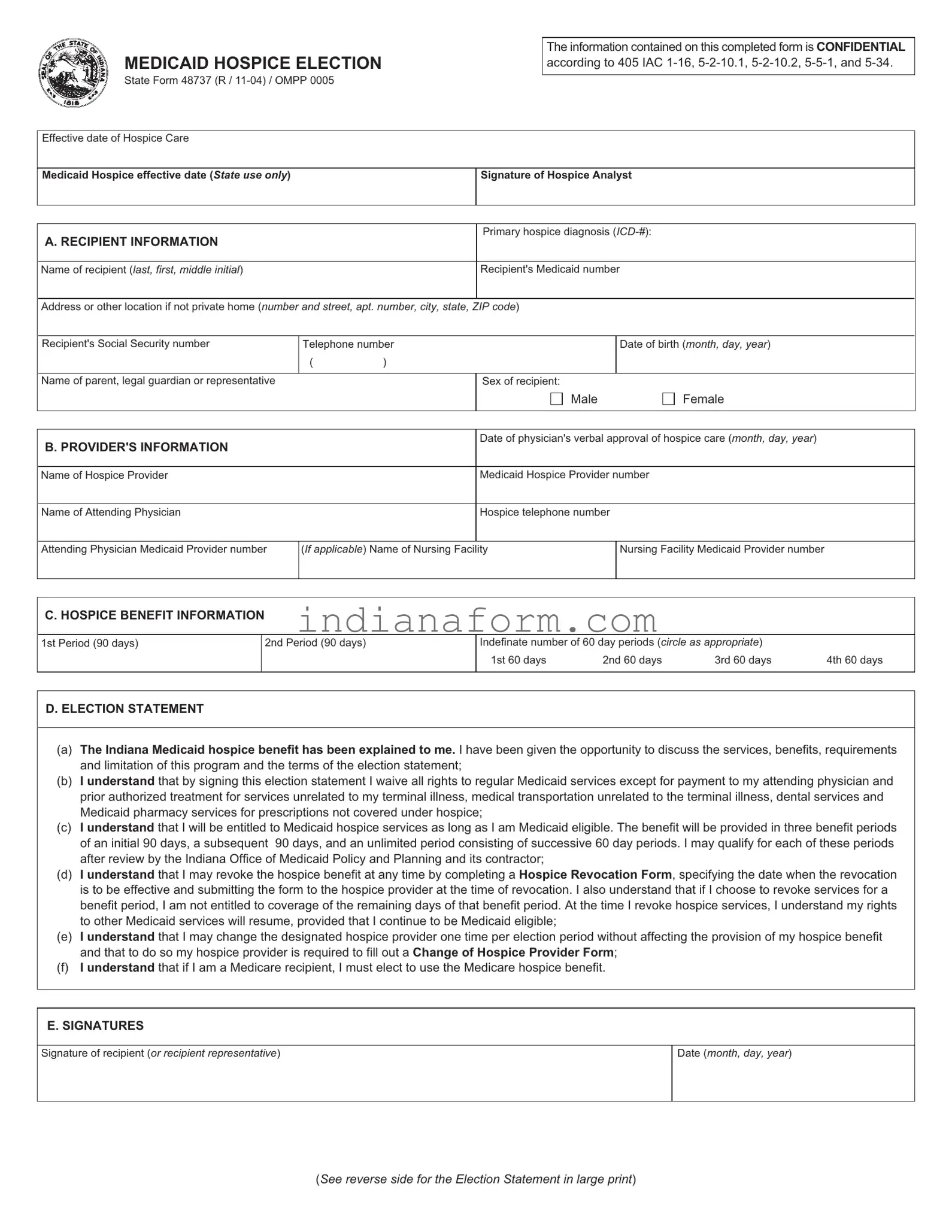What is State Form 48737 used for?
State Form 48737 is designed for Medicaid recipients in Indiana who wish to elect hospice care. This form is pivotal as it documents the recipient's formal choice of foregoing standard Medicaid benefits in favor of receiving hospice care, which is tailored to provide comfort and support to individuals with terminal illnesses. By completing this form, individuals communicate their understanding and acceptance of the hospice benefits, limitations, and conditions, including specific rights and waivers associated with the hospice election.
How does electing hospice care through State Form 48737 affect my existing Medicaid benefits?
When you elect hospice care using State Form 48737, you agree to waive regular Medicaid services related to the treatment of your terminal illness except for certain services. Those exceptions include treatment by your attending physician that is unrelated to your terminal condition, authorized dental services, medical transportation not related to the terminal illness, and pharmacy benefits for prescriptions not covered under the hospice benefit. Essentially, your Medicaid coverage will focus on providing comprehensive hospice care while limiting other Medicaid services not associated with managing your terminal illness.
Can I change my hospice provider after electing hospice care?
Yes, you have the right to change your designated hospice provider one time per election period without affecting your hospice benefits. This requires your new hospice provider to complete a Change of Hospice Provider Form. This flexibility ensures that you can seek care from a provider that best meets your needs and preferences while still under Medicaid hospice care.
What happens if I decide to revoke my hospice election?
If you decide to revoke your hospice care election, you must complete a Hospice Revocation Form, indicating the effective date of revocation. Upon revocation, you will not be entitled to coverage for the remaining days of that benefit period, but your right to other Medicaid services will resume, assuming you remain Medicaid eligible. This option provides flexibility, allowing you to return to regular Medicaid services if your health condition changes or if you decide hospice care is no longer the best option for you.
Am I eligible for Medicaid hospice services after completing State Form 48737?
Eligibility for Medicaid hospice services after completing State Form 48737 requires an initial determination that you have a terminal illness and meet all Medicaid eligibility requirements. Following this, the benefit is provided in three distinct periods: an initial 90 days, a subsequent 90 days, and unlimited successive 60-day periods, each requiring approval from the Indiana Office of Medicaid Policy and Planning and its contractor. This structured eligibility ensures that as long as you are Medicaid eligible, you can receive hospice care tailored to your stage of illness.
What information is required when completing State Form 48737?
Completing State Form 48737 requires detailed information about the Medicaid recipient, including their name, Medicaid number, social security number, address, and contact information. It also necessitates details about the primary hospice diagnosis, physician's approval date, hospice provider information, and attending physician's details. Additionally, the recipient (or their representative) must sign the form, acknowledging an understanding of the hospice benefit, waivers, and rights as detailed in the election statement.
What is the significance of the effective date of hospice care on State Form 48737?
The effective date of hospice care, as noted on State Form 48737 and to be filled out by state use only, marks the commencement of your hospice benefits under Medicaid. This date is crucial as it signals the beginning of hospice care coverage and the transition from regular Medicaid services to hospice-specific benefits. Understanding this date is essential for both the recipient and the hospice provider, ensuring that care is appropriately coordinated and billed under Medicaid from the outset of hospice services.


